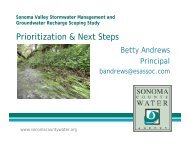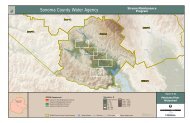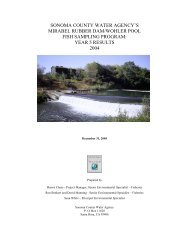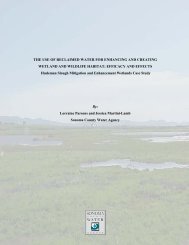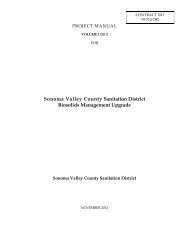Chapter 3 Water Reuse - Sonoma County Water Agency - State of ...
Chapter 3 Water Reuse - Sonoma County Water Agency - State of ...
Chapter 3 Water Reuse - Sonoma County Water Agency - State of ...
Create successful ePaper yourself
Turn your PDF publications into a flip-book with our unique Google optimized e-Paper software.
<strong>Water</strong> Smart Development Guidebook<br />
<strong>Chapter</strong> 3. <strong>Water</strong> <strong>Reuse</strong><br />
and more households in both urban and rural areas to implement graywater reuse for landscape<br />
irrigation.<br />
There are a handful <strong>of</strong> known permitted graywater systems in the <strong>Sonoma</strong> <strong>County</strong>:<br />
• Trathen Heckman’s house, Petaluma: Trathen Heckman, founder <strong>of</strong> Daily Acts and<br />
member <strong>of</strong> the City <strong>of</strong> Petaluma Green Team, coordinated the first permitted residential<br />
graywater system in <strong>Sonoma</strong> <strong>County</strong> at his Petaluma home in 2008. The system features<br />
a constructed wetland that treats water from the home’s bathroom sinks, showers, and<br />
clothes washer. Approximately 36,000 gallons per year are expected to be generated by<br />
the system for use in the home’s backyard (Young 2008).<br />
• Osmosis Day Spa, Freestone: Osmosis Day Spa installed a graywater system including<br />
constructed wetlands in 2009 that is estimated to <strong>of</strong>fset 1,000 gallons per day in potable<br />
water demands for outdoor irrigation. The graywater system allowed Osmosis to<br />
decommission an existing septic leach field that was within a creek floodplain. As such,<br />
Osmosis has recently completed constructed wetlands that treat nearly 1,000 gallons <strong>of</strong><br />
graywater per day for landscape irrigation (Osmosis 2009).<br />
• Florence L<strong>of</strong>ts, Sebastopol: Florence L<strong>of</strong>ts is a 12‐unit live/work complex that was<br />
developed by IBIS. Designers expect to capture and re‐circulate about 150,000 gallons<br />
<strong>of</strong> gray water a year, enough to meet all <strong>of</strong> the project’s irrigation needs (McConahey<br />
2008).<br />
• Lyding Commons, Sebastopol: Another development by IBIS, Lyding Commons consists<br />
<strong>of</strong> four mixed‐use buildings. The complex has a similar graywater system to Florence<br />
L<strong>of</strong>ts.<br />
The above projects were all permitted before the 2010 Graywater Standards were adopted in<br />
August 2009 but have graywater systems that are complex enough that they would still require<br />
permits under the new code. Osmosis Day Spa, Florence L<strong>of</strong>ts and Lyding Commons were<br />
permitted by <strong>Sonoma</strong> <strong>County</strong>, whereas the Petaluma project was permitted by the City <strong>of</strong><br />
Petaluma. No permitted graywater systems for indoor uses (such as toilet flushing) are known<br />
to exist in <strong>Sonoma</strong> <strong>County</strong>.<br />
3.3.4 Local Opportunities for <strong>Water</strong> Conservation through Expanded<br />
Graywater Use<br />
The extent to which graywater use can <strong>of</strong>fset potable demands depends on how much<br />
graywater can practically be collected and how the graywater is used. Graywater constitutes<br />
approximately 50% <strong>of</strong> the total wastewater generated within a household (WERF 2006) but<br />
capturing all <strong>of</strong> this graywater would require a substantial system that collects water from all<br />
showers and bathroom sinks, as well as the clothes washer. Most existing graywater systems,<br />
<strong>Sonoma</strong> <strong>County</strong> <strong>Water</strong> <strong>Agency</strong><br />
May 2011 3‐13




